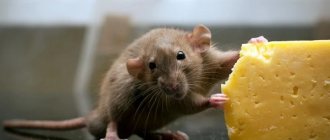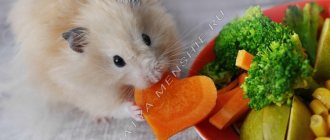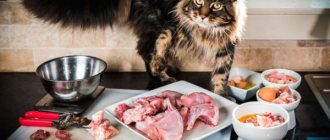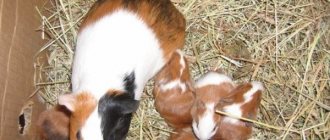- home
- Guinea pig
- Guinea pig nutrition
04/04/2019 Guinea pigs are often chosen as pets, which in a short time become attached to their owner. In the wild, these animals worry about their own food. In captivity, this care falls on the shoulders of the owner. It is important to know what to feed your guinea pig at home in order to keep it healthy and extend its life cycle.
What food to give your guinea pig
Guinea pigs eat a variety of foods and greens. According to the recommendations of experienced specialists, the pet’s diet should be varied and balanced. ½ of the total menu should be hay. The remaining 50% of the diet is dry food, succulent food and greens.
Dry food
Dry food includes grain crops and factory-produced granulated mixtures (special food for domestic guinea pigs).
Healthy grain feeds:
- millet;
- barley;
- sunflower seed;
- oats;
- corn grains.
Ready-made mixtures may contain vitamin complexes.
Grains should be in the guinea pig's diet every day and should always be freely available to the pet.
Hay and branches
Hay is the most useful and necessary product for guinea pigs. It improves the functioning of the digestive tract and prevents the development of intestinal diseases, and also helps to grind down the back teeth.
What kind of hay to give your pet:
- fresh, with a natural grassy smell;
- free from dust and other contaminants;
- small bundles (can be pre-cut or rolled into a roll);
- without coarse and large branches.
This food also needs to be given to your guinea pig every day. You can make hay yourself or purchase it ready-made in a store.
Green food
Another important product in the diet of domestic guinea pigs is green food. This is meadow or field grass grown in ecologically clean areas (away from polluted road areas).
Green herbs contain many useful and nutritious substances necessary for the healthy functioning of the body of guinea pigs. In addition, these animals happily eat fresh herbs, as well as equally healthy greens - spinach, dill, parsley, celery, lettuce, etc.
Healthy green food for guinea pigs:
- plantain leaves, dandelion;
- clover;
- cilantro;
- carrot tops;
- yarrow;
- chamomile, etc.
Juicy food
Juicy food for guinea pigs includes fruits and vegetables, as well as some berries, served to the pet as a tasty treat.
What juicy foods can you give:
- beets (fodder, red);
- fresh cucumbers;
- cauliflower and Brussels sprouts;
- carrot;
- Bell pepper;
- tubers and leaves of earthen pear;
- apples;
- garden sow thistle;
- corn cobs;
- zucchini;
- tomatoes;
- grapes (seedless only);
- pumpkin;
- green peas.
As a delicious dessert, you can sometimes pamper your pets with raspberries, wild strawberries, currants, strawberries and tangerines, which are rich in vitamin C.
Treats and vitamins
The body of guinea pigs especially needs vitamin C, so foods rich in ascorbic acid must be present in the daily diet of rodents. Salts and calcium are also important for them. To saturate the body with useful minerals, it is recommended to use special mineral stones from the store.
Healthy treats for guinea pigs:
- dried fruits;
- fruit slices;
- wheat bran;
- fresh cherry branches;
- mint;
- pea pods;
- peeled flax, sesame, pumpkin, sunflower seeds.
What else can you give?
In order for a guinea pig to wear down its teeth, it must be given tree branches to chew on. Branches should be collected away from the road. Before feeding, the branches must be cleared of dirt and washed under running hot water.
Which tree branches can be given:
- Birches;
- Linden trees;
- And you;
- Apple trees;
- Pears;
- Cherries;
- Rowan trees.
In addition to food, the animal needs vitamins. The kewi's body is designed in such a way that it cannot obtain vitamin C from regular food. A lack of this vitamin leads to various diseases, so additional feeding is necessary.
One adult should be given 5-15 mg of ascorbic acid daily. The vitamin can be dissolved in a glass of water and poured into a drinking bowl.
What to feed a pregnant guinea pig and newborn babies
Pregnant rodents need high-quality and nutritious nutrition. Rose hips, which are served to pets in the form of an infusion, are very beneficial for the body. You should also include wheat sprouts, beets and fresh carrots in your daily diet.
The diet of newborn pigs should contain foods rich in vitamins and proteins. For the first two weeks, babies feed on mother's milk. If it is missing, the owner will have to feed the small offspring; it is better to consult a veterinarian for advice.
Already from the second day of life, little guinea pigs begin to try different foods, so it is necessary to ensure that the cage contains:
- Juicy;
- Greens;
- Industrial feed.
Hay
The most important food for guinea pigs. Hay not only normalizes the functioning of the intestinal tract, but is also an excellent tool for grinding down the incisors of rodents. Like grain, hay is sold at any pet store. When purchasing, it is important to carefully check that the dried grass is not affected by mold. Rotten and moldy hay can harm your pet's body. If the owner is engaged in the preparation of hay on his own, then he must carefully inspect the collected grass for the presence of prickly, weeds, and poisonous plants.
List of approved products
The diet of guinea pigs is based on foods such as vegetables, fruits, berries, garden and meadow greens, sunflower seeds, seeds, twigs of trees and shrubs.
Healthy and safe food for guinea pigs:
- Vegetables - cucumber, carrots, beets, pumpkin, fennel, zucchini, turnips, parsnips and celery in tubers. In small quantities you can treat your pet to bell peppers, tomatoes, artichokes, cauliflower, rutabaga, and Jerusalem artichoke.
- Fruits – seedless grapes, plums, apples, pears. Bananas, peaches, apricots, watermelon, melon, kiwi, pineapples, oranges and tangerines are served in small quantities.
- Berries - currants, raspberries, blueberries, cherries, sweet cherries, strawberries. In limited quantities - gooseberries, sea buckthorn, blackberries, cranberries, rowan.
- Garden greens - lettuce leaves, dill, celery, sprouted cereal grains, carrot tops, beets, corn cobs. In limited quantities - cilantro, spinach, parsley.
- Meadow greens - nettle, clover, yarrow, alfalfa, plantain, sage, echinacea, burdock, chamomile. Milk thistle, coltsfoot, dandelion, St. John's wort, wormwood, and fireweed are served in small quantities.
- Flax seeds are useful. In limited quantities - sesame seeds, dill, pumpkin and sunflower seeds.
- Useful branches of bushes and trees - birch, mulberry, hazel, pear, raspberry, ash, hawthorn, blueberry, maple and cherry plum. Sometimes you can pamper your pet with branches of chestnut, cherry, aspen, apricot, cherry, willow, poplar and rowan.
- It is not often that a rodent can be fed green peas and asparagus in small quantities.
Vegetable menu
The main task of vitamin C in the rodent body is to control the functioning of connective and bone tissues. Animals have to look for it from external sources, since the animal body is not able to produce it in such quantities.
Pigs' favorites on the menu most often include apples, carrots and cucumbers. Vitamin C can enter the animal’s body through raw food of plant origin.
It is important to give them to your pet at least 1 teaspoon per day
Veterinarians also list the following as approved products:
- Zucchini is allowed due to its high content of minerals and pectins, which normalize the functioning of intestinal permeability.
- Carrots have a positive effect on the condition of the animal’s coat and skin, as well as visual and auditory function. You can give not only the fruit itself, but also well-washed tops. Due to the content of Vitamin A, urine may turn orange.
- Bell pepper can be given to animals only during the season, due to the fact that winter varieties are oversaturated with nitrates. Only sweet varieties are allowed to serve as food.
- Pumpkin is also given to the animal almost completely. And zinc contained in the seeds is a strong preventative against helminthiases.
- Cucumbers themselves are low in calories, safe and have the ability to help digest heavy fats.
- Fresh peas are also acceptable, but in small quantities. Despite the disapproval of veterinarians. Some food manufacturers add the essence of the fruit to their mixtures, despite the fact that they can cause a negative side reaction in the animal.
- Cabbage is also allowed, but subject to proper supervision. While it causes gas in some people, excessive use can be dangerous for pigs. It is worth introducing it into the diet gradually, observing the reaction of your friend.
- Rutabaga facilitates bowel movements and helps avoid constipation. Best suited for your pet's winter diet.
- Jerusalem artichoke can be given as a treat, strictly limiting its total amount in the animal’s diet. The root vegetable itself is the most dangerous; other parts of the plant can be given constantly.
The most undesirable products include:
- Tomatoes are especially considered dangerous when green. They contain solanine, in addition, the use of tops is also not recommended. Ripe tomatoes, due to the destruction of poisons, can be included in the diet in small quantities. If you overdo it, the animal may experience intestinal upset and problems with the gastrointestinal tract.
- Potatoes are prohibited due to starch and solanine.
- Melon has a risk of developing diabetes due to the abundance of sugars.
- Radish and radish oils can cause bloating.
- Beetroot has a stable effect and is not particularly recommended for pregnant females. Root vegetables and tops are recommended for healthy individuals in small quantities. After eating beets, the animal’s urine may temporarily acquire a red tint.
- Corn is prohibited for pigs; only tops are allowed. And grains contain a large amount of starch, which can cause obesity.
What not to feed a guinea pig
There is a list of harmful foods that you should absolutely not feed to your pet guinea pig. They are absolutely useless for their body, and some of them can cause serious health problems.
What not to give to rodents:
- Prohibited vegetables: radish, radish, onion, potato, eggplant, garlic, horseradish.
- Harmful fruits: dates, persimmons, lemon, lime, pomegranates and grapefruits.
- Do not feed your pet sorrel, rhubarb greens, green onions, garlic, as well as lavender, motherwort, celandine, belladonna, serpentine, valerian, wild rosemary, fern, sow thistle and hemp seeds.
- Branches of fir, quince, oak, pine and spruce are prohibited for rodent food.
- Beans and boiled peas should not be given as legume products.
- Meat and dairy products, eggs, sweets and baked goods are prohibited in any form.
It is also unacceptable to give guinea pigs food from your table, low-quality food, spoiled and stale food, indoor greens, canned food, spices, mushrooms and fruit seeds.
Delicious additives
Juicy fruits are taken as tasty additives for rodents, namely:
- Sweet apples. Rodents love them very much in any form. Apple fruits contain fiber, pectin, vitamin B, and carotene. Green fruits contain much less vitamins compared to ripe apples. You should not give your pig spoiled or rotten apples, as this can lead to gastrointestinal upset. The affected areas should be cut out and the fruit should be washed well under running cold water.
- Strawberries. Contains a large amount of nutrients: vitamins E, C, A, iron, phosphorus, calcium. Small animals like red berries; they increase appetite and have a positive effect on digestion. In addition, strawberries have a diuretic effect.
Guinea pig diet
Cereals and pelleted feeds
This type of diet is based on grain crops and ready-made food, containing all the necessary vitamins and mineral supplements for the healthy growth and development of a domestic rodent.
Nutrition Features:
- You need to buy only high-quality food from trusted manufacturers for your guinea pig. Cheap food contains many harmful and unnatural ingredients that can cause serious health problems.
- Dry food must be supplemented with moist, juicy food.
- Clean drinking water should always be freely available to your pet.
- It is not advisable to feed high-calorie foods to inactive rodents.
Advantages of nutrition: ready-made food has a solid structure, which helps the animal grind its teeth, convenient use of food, no need to prepare special food for the rodent.
Disadvantages: you need to constantly purchase food for your pet and always have a certain supply of it in the house.
On our store’s website you can select and buy high-quality industrial food for domestic guinea pigs from reliable global manufacturers. The range includes cozy cages for rodents, comfortable drinking bowls, special toilets with nozzles, various accessories for games and much more.
Reproduction
The female is ready to reproduce offspring already at the 5th month from birth, the male guinea pig at the 6th. But breeders recommend that the first matings be carried out no earlier than the pets are 10 months old. Animals of the same breed and age that are not related to each other are chosen as parents. Obese individuals are not suitable for reproduction.
Females are ready to breed every two weeks or month for two days. 10 days before the onset of estrus, vitamin E is added to the female’s diet. It is best if the female becomes pregnant no later than November, then she will have time to feed her offspring before the onset of molting. Molting is a difficult process for an animal; in combination with feeding, it puts a lot of stress on the female’s body.
It is easy to determine that a female is ready to mate. She lifts the back of her body, spreading her paws to the side.
Fertilization occurred if the female did not start another estrus within 20 days. Then she is transplanted into a separate cage.
The female's pregnancy lasts 10 weeks. At this time, you don’t need to carry her in your arms, often take her out of the cage and fiddle with her unnecessarily. Excess stress can lead to miscarriage.
Mother pigs can develop toxicosis. It occurs in the period before and immediately after childbirth. At this time, females experience muscle cramps, loss of appetite, deterioration of coat condition, and drooling. Toxicosis can be avoided if you make the right diet, add vitamins and prevent stress. Toxicosis also occurs due to pregnancy with many children. Females usually give birth to 3 to 5 piglets.
Guinea pigs usually give birth as usual and last about half an hour. Newborns can see and hear and also have incisors. 2 days after birth, they can already eat regular food. And when they are a month old, they can be moved into a cage for further independent life.
Before getting a guinea pig, study information about these cute rodents. Caring for the animals will be easy for novice breeders. However, the owner is responsible for the health and well-being of his pet. After all, only a healthy animal will be cheerful and playful and bring joy to its owner.
Guinea pig feeding
Guinea pigs need to be fed correctly, avoiding overeating and obesity of the pet. The serving quantity is determined by the type of diet and the age of the animal.
Quantity and quality of food
The amount of daily serving of grain-free food is up to 30% of the pet’s total body weight. After feeding, food is removed from the cage. Only hay and young branches of bushes or trees can be left freely available.
One serving of grain food for an adult pet is 1/2 tablespoon. In addition to dry food, you can pamper your rodent with small amounts of pieces of fruit and vegetables.
All food served to a pet rodent must be fresh and of high quality. Under no circumstances should you give your pet spoiled vegetables or fruits. Such food can cause serious poisoning.
The feed dosage is doubled when feeding pregnant guinea pigs. You need to introduce more juicy and green foods into your diet, rich in healthy vitamins and mineral complexes.
How many times a day should you feed your guinea pig?
Grain feeding is served no more than 2 times a day. It is advisable to follow a feeding schedule and give food at the same time. Uneaten dry food may remain in your pet's feeder all the time.
Water
Clean drinking water should always be in your pet rodent's drinking bowl. An adult pet can drink up to 250 ml of liquid per day. Pregnant guinea pigs drink even more water.
Pet rodents should be given filtered or bottled clean water. For convenient and safe storage of liquid in a cage, it is recommended to use a special closed drinking bowl that does not contain dust or other debris. Pathogenic microorganisms that are unsafe for the animal’s body can multiply in contaminated water.
Guinea pigs should not be given any sweet, carbonated or dairy drinks. You can only give your pet regular water and not boiled water!
Fruits and berries
Bananas
Can guinea pigs have bananas? A banana rich in potassium will benefit your guinea pig, but you should not give more than 1 piece per day.
The peel of the vegetable must be removed, as it is treated with substances hazardous to health (wax, chemicals, ethylene and pesticides). For safety, it is better to remove soft fibers from the fruit.
Can guinea pigs eat a pear?
Pears can be given with the peel, but without the seeds. The fruit is washed well and cut into pieces; the pig should be offered water along with it. Excessive consumption of pears due to their high sugar content can cause diarrhea.
Can guinea pigs eat kiwi?
Kiwi is a very healthy fruit for animals. It contains a large amount of ascorbic and folic acids. It is also rich in vitamins E, iron, calcium, magnesium and phosphorus.
Kiwi is given without skin in the form of small pieces. For your pet, you need to choose harder fruits. It is better to control the amount you eat. An increase in the dose of kiwi is permissible in autumn and winter, as well as when feeding females during pregnancy and lactation.
Can guinea pigs have oranges and other citrus fruits?
Can be used occasionally. But it is better for guinea pigs to get vitamin C from other foods, avoiding citrus fruits. Possible complications:
Can guinea pigs eat apples?
Apples can be raw or dried. They have a balanced ratio of sugar and fructose (18:80%). It allows the pig to be active.
The fruit must be peeled and cut into slices. It is better not to give more than 3 pieces at a time.
Can guinea pigs eat strawberries, grapes and other berries?
Strawberries contain a sufficient amount of vitamin C to pay attention to the berry when choosing a treat for a rodent. You can also give strawberry leaves to animals.











